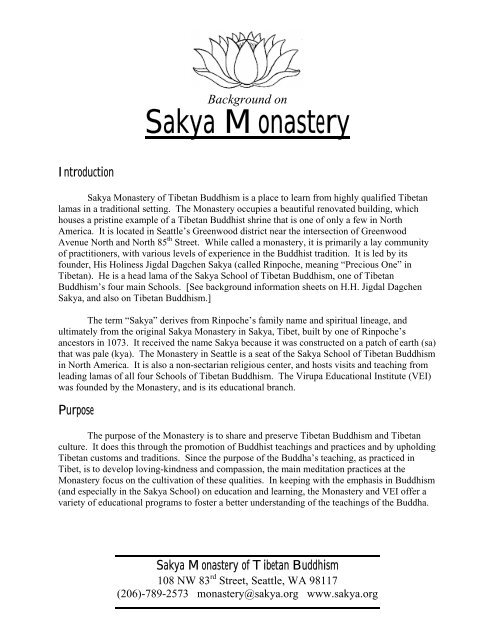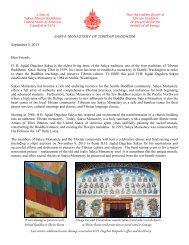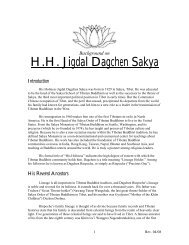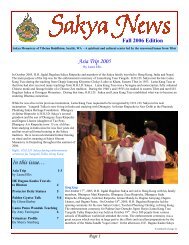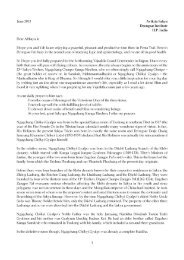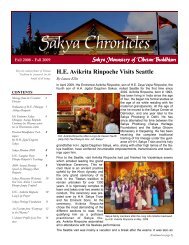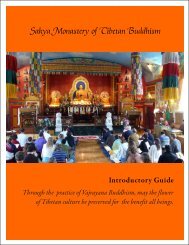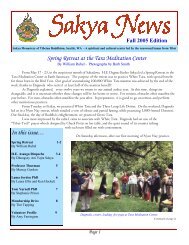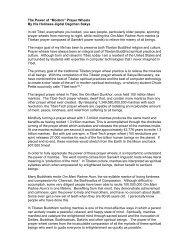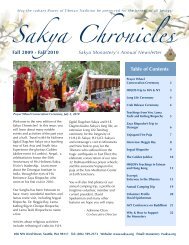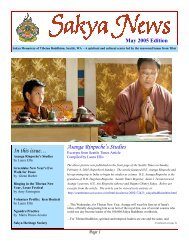Sakya Monastery.pdf - the Sakya Monastery of Tibetan Buddhism
Sakya Monastery.pdf - the Sakya Monastery of Tibetan Buddhism
Sakya Monastery.pdf - the Sakya Monastery of Tibetan Buddhism
Create successful ePaper yourself
Turn your PDF publications into a flip-book with our unique Google optimized e-Paper software.
Background on<strong>Sakya</strong> <strong>Monastery</strong>Introduction<strong>Sakya</strong> <strong>Monastery</strong> <strong>of</strong> <strong>Tibetan</strong> <strong>Buddhism</strong> is a place to learn from highly qualified <strong>Tibetan</strong>lamas in a traditional setting. The <strong>Monastery</strong> occupies a beautiful renovated building, whichhouses a pristine example <strong>of</strong> a <strong>Tibetan</strong> Buddhist shrine that is one <strong>of</strong> only a few in NorthAmerica. It is located in Seattle’s Greenwood district near <strong>the</strong> intersection <strong>of</strong> GreenwoodAvenue North and North 85 th Street. While called a monastery, it is primarily a lay community<strong>of</strong> practitioners, with various levels <strong>of</strong> experience in <strong>the</strong> Buddhist tradition. It is led by itsfounder, His Holiness Jigdal Dagchen <strong>Sakya</strong> (called Rinpoche, meaning “Precious One” in<strong>Tibetan</strong>). He is a head lama <strong>of</strong> <strong>the</strong> <strong>Sakya</strong> School <strong>of</strong> <strong>Tibetan</strong> <strong>Buddhism</strong>, one <strong>of</strong> <strong>Tibetan</strong><strong>Buddhism</strong>’s four main Schools. [See background information sheets on H.H. Jigdal Dagchen<strong>Sakya</strong>, and also on <strong>Tibetan</strong> <strong>Buddhism</strong>.]The term “<strong>Sakya</strong>” derives from Rinpoche’s family name and spiritual lineage, andultimately from <strong>the</strong> original <strong>Sakya</strong> <strong>Monastery</strong> in <strong>Sakya</strong>, Tibet, built by one <strong>of</strong> Rinpoche’sancestors in 1073. It received <strong>the</strong> name <strong>Sakya</strong> because it was constructed on a patch <strong>of</strong> earth (sa)that was pale (kya). The <strong>Monastery</strong> in Seattle is a seat <strong>of</strong> <strong>the</strong> <strong>Sakya</strong> School <strong>of</strong> <strong>Tibetan</strong> <strong>Buddhism</strong>in North America. It is also a non-sectarian religious center, and hosts visits and teaching fromleading lamas <strong>of</strong> all four Schools <strong>of</strong> <strong>Tibetan</strong> <strong>Buddhism</strong>. The Virupa Educational Institute (VEI)was founded by <strong>the</strong> <strong>Monastery</strong>, and is its educational branch.PurposeThe purpose <strong>of</strong> <strong>the</strong> <strong>Monastery</strong> is to share and preserve <strong>Tibetan</strong> <strong>Buddhism</strong> and <strong>Tibetan</strong>culture. It does this through <strong>the</strong> promotion <strong>of</strong> Buddhist teachings and practices and by upholding<strong>Tibetan</strong> customs and traditions. Since <strong>the</strong> purpose <strong>of</strong> <strong>the</strong> Buddha’s teaching, as practiced inTibet, is to develop loving-kindness and compassion, <strong>the</strong> main meditation practices at <strong>the</strong><strong>Monastery</strong> focus on <strong>the</strong> cultivation <strong>of</strong> <strong>the</strong>se qualities. In keeping with <strong>the</strong> emphasis in <strong>Buddhism</strong>(and especially in <strong>the</strong> <strong>Sakya</strong> School) on education and learning, <strong>the</strong> <strong>Monastery</strong> and VEI <strong>of</strong>fer avariety <strong>of</strong> educational programs to foster a better understanding <strong>of</strong> <strong>the</strong> teachings <strong>of</strong> <strong>the</strong> Buddha.<strong>Sakya</strong> <strong>Monastery</strong> <strong>of</strong> <strong>Tibetan</strong> <strong>Buddhism</strong>108 NW 83 rd Street, Seattle, WA 98117(206)-789-2573 monastery@sakya.org www.sakya.org
The BuildingThe <strong>Monastery</strong>’s building was initially erected in 1928 as <strong>the</strong> First Presbyterian Church.Over <strong>the</strong> years, different Christian denominations have owned <strong>the</strong> building. In 1984, a Baptistgroup sold it to <strong>Sakya</strong> Tegchen Choling center (<strong>Sakya</strong> <strong>Monastery</strong>’s predecessor). Since it’sfounding in 1974, this center had successively outgrown accommodations in <strong>the</strong> Ravenna-Bryant, Capitol Hill, Wallingford, and University districts. When it moved to <strong>the</strong> Greenwoodarea, <strong>the</strong> center reorganized under H.H. Jigdal Dagchen <strong>Sakya</strong>, and adopted <strong>the</strong> name <strong>Sakya</strong><strong>Monastery</strong> <strong>of</strong> <strong>Tibetan</strong> <strong>Buddhism</strong>.Buying <strong>the</strong> large structure in Greenwood was a big step for <strong>the</strong> small center. Aremarkable event helped catalyze <strong>the</strong> purchase <strong>of</strong> <strong>the</strong> building. While <strong>the</strong> search was beingconducted for <strong>the</strong> center’s new home, Rinpoche had a dream in which he saw <strong>the</strong> destinedbuilding. Upon waking, he had architectural plans drawn for <strong>the</strong> building as revealed to him inhis vision. Amazingly, <strong>the</strong> Baptist Church was an exact match for <strong>the</strong>se vision-based plans and<strong>the</strong> decision was made to acquire <strong>the</strong> building.Since <strong>the</strong> purchase, many years <strong>of</strong> hard work and renovation by dedicated volunteershave brought <strong>the</strong> building to its present form and grace. At various stages <strong>of</strong> <strong>the</strong> renovation, <strong>the</strong>highest-ranking lamas in <strong>Tibetan</strong> <strong>Buddhism</strong>, including His Holiness <strong>the</strong> Dalai Lama, haveconsecrated <strong>the</strong> <strong>Monastery</strong>’s building and its contents, imbuing <strong>the</strong>m with <strong>the</strong> enlightened spirit<strong>of</strong> <strong>the</strong> Buddha and transforming <strong>the</strong> building into a North American home for <strong>the</strong> Buddha’steaching. In addition, <strong>the</strong> monastery contains many holy objects from India, Tibet, and Nepal.Following <strong>the</strong> first year <strong>of</strong> renovation, <strong>the</strong> downstairs cultural hall began to be used as aninterim location for <strong>the</strong> <strong>Monastery</strong>’s religious services. For <strong>the</strong> next twelve years <strong>the</strong> mainworship hall (<strong>the</strong> shrine room) underwent remodeling. Numerous Buddhist artworks weredonated by <strong>the</strong> <strong>Monastery</strong>’s members, friends, as well as by pr<strong>of</strong>essional artists and Rinpoche’sfamily. Extensive murals were painted on site. During this period, Bernardo Bertolucci shotscenes for <strong>the</strong> film Little Buddha at <strong>the</strong> <strong>Monastery</strong>. This venture helped pay for <strong>the</strong> new woodparquet floor in <strong>the</strong> shrine room. Outside <strong>the</strong> building, in keeping with <strong>the</strong> style <strong>of</strong> traditional<strong>Tibetan</strong> monasteries, a portico was added over <strong>the</strong> front entrance. By 1997, <strong>the</strong> remodeling wassufficiently finished so that <strong>the</strong> main shrine room could be used for meditations.In 1998, <strong>the</strong> outside <strong>of</strong> <strong>the</strong> <strong>Monastery</strong>’s building was painted in traditional <strong>Tibetan</strong> colorsand a memorial stupa was erected to Deshung Rinpoche (<strong>the</strong> lama who co-founded <strong>the</strong> original<strong>Sakya</strong> Tegchen Choling center). The bell shaped stupa is located in front <strong>of</strong> <strong>the</strong> <strong>Monastery</strong> andsymbolizes <strong>the</strong> Buddha’s enlightened mind. In 2001, a library addition capable <strong>of</strong> holding atleast 5,000 volumes was finished and opened.Two Levels <strong>of</strong> Religious TrainingIn <strong>Tibetan</strong> <strong>Buddhism</strong>, a religious community traditionally needs both a monastery and aretreat center. A <strong>Monastery</strong> maintains and preserves <strong>the</strong> teaching <strong>of</strong> <strong>the</strong> Buddha throughteaching, training, and practice. It houses monks who are trained in <strong>the</strong> intellectual, moral andritual teachings <strong>of</strong> <strong>the</strong> Buddha and is a focal point for religious activities <strong>of</strong> <strong>the</strong> lay community.2 Rev. 02/08
Nowadays, with <strong>the</strong> rapid changes taking place in Tibet, <strong>the</strong> monastery is also a place where<strong>Tibetan</strong>s endeavor to preserve <strong>the</strong>ir unique <strong>Tibetan</strong> identity and culture.The bustle <strong>of</strong> activity at a monastery means that it is not always conducive to developingpr<strong>of</strong>ound meditative experiences. For that, an isolated retreat center is necessary. In 2000, a<strong>Sakya</strong> <strong>Monastery</strong> student made a house and 72 acres <strong>of</strong> forest and ponds located on WhidbeyIsland available for use as a place for spiritual retreats. Thus, with teaching facilities in Seattleand a mediation center on Whidbey Island, <strong>Sakya</strong> <strong>Monastery</strong> provides a complete array <strong>of</strong>traditional methods <strong>of</strong> <strong>Tibetan</strong> religious training for <strong>the</strong> lay community as well as monks andnuns.Programs and Administration<strong>Sakya</strong> <strong>Monastery</strong> <strong>of</strong>fers a variety <strong>of</strong> activities for its members and friends. Foremost are<strong>the</strong> public meditations: Chenrezi meditations for developing loving-kindness and compassion areheld on Sunday morning at 10 am and Thursday evenings at 8 pm during daylight savings time(spring/summer) and 7:30pm during standard time (fall/winter). This is <strong>the</strong> main communalpractice <strong>of</strong> <strong>Sakya</strong> <strong>Monastery</strong>. Calm Abiding meditations, which are useful for <strong>the</strong> development<strong>of</strong> concentration and mental stability, are held on Friday nights at 7:00 pm.Numerous o<strong>the</strong>r ceremonies and meditations are held at <strong>the</strong> <strong>Monastery</strong>:• Buddhist holy days – such as <strong>the</strong> birth <strong>of</strong> <strong>the</strong> Buddha, and lama memorials.• Refuge ceremonies are regularly scheduled for people who wish to formally join <strong>the</strong>community <strong>of</strong> Buddhist practitioners and become a Buddhist.• Initiatory ceremonies, called “empowerments”, are bestowed by Rinpoche and o<strong>the</strong>rlamas upon request. These are required as a basis for special meditation practicesinvolving deities such as Chenrezi (<strong>the</strong> embodiment <strong>of</strong> compassion) or Green Tara (<strong>the</strong>grantor <strong>of</strong> protection).• Monthly meditations are also held that have specific requirements for practicing – such asbeing a Buddhist, or having received a specific empowerment or level <strong>of</strong> empowerment.Additionally, <strong>the</strong> <strong>Monastery</strong> <strong>of</strong>fers a variety <strong>of</strong> o<strong>the</strong>r programs and resources: TheChildren’s Dharma School for children ages 5 to 9 is available every Sundays. The <strong>Monastery</strong>library, available to members and visiting scholars, houses 2,500 books on <strong>Buddhism</strong>, Tibet, andcomparative religion, as well as audiotapes <strong>of</strong> teachings in <strong>Tibetan</strong> by noted lamas. The libraryhas a connection with <strong>the</strong> <strong>Tibetan</strong> Works & Archives in Dharamsala, Himachal Pradesh, India(home <strong>of</strong> <strong>the</strong> <strong>Tibetan</strong> Government-in-Exile). The Virupa Educational Institute administers andorganizes numerous classes, talks, book groups, discussions, and video showings held at <strong>the</strong><strong>Monastery</strong>. These programs are open to <strong>the</strong> public and are widely attended.Following <strong>Tibetan</strong> tradition, its Head Lama, H.H. Jigdal Dagchen <strong>Sakya</strong>, administrativelyleads <strong>the</strong> <strong>Monastery</strong>. He consults regularly with a fourteen-member Advisory Board. Ten <strong>of</strong> <strong>the</strong>Board’s members are elected by <strong>the</strong> members <strong>of</strong> <strong>the</strong> <strong>Monastery</strong>; <strong>the</strong> o<strong>the</strong>r four are <strong>the</strong> HeadLama, <strong>the</strong> <strong>Tibetan</strong> Cultural Advisor, <strong>the</strong> Executive Director, and an appointee drawn from <strong>the</strong><strong>Sakya</strong> family.3 Rev. 02/08


